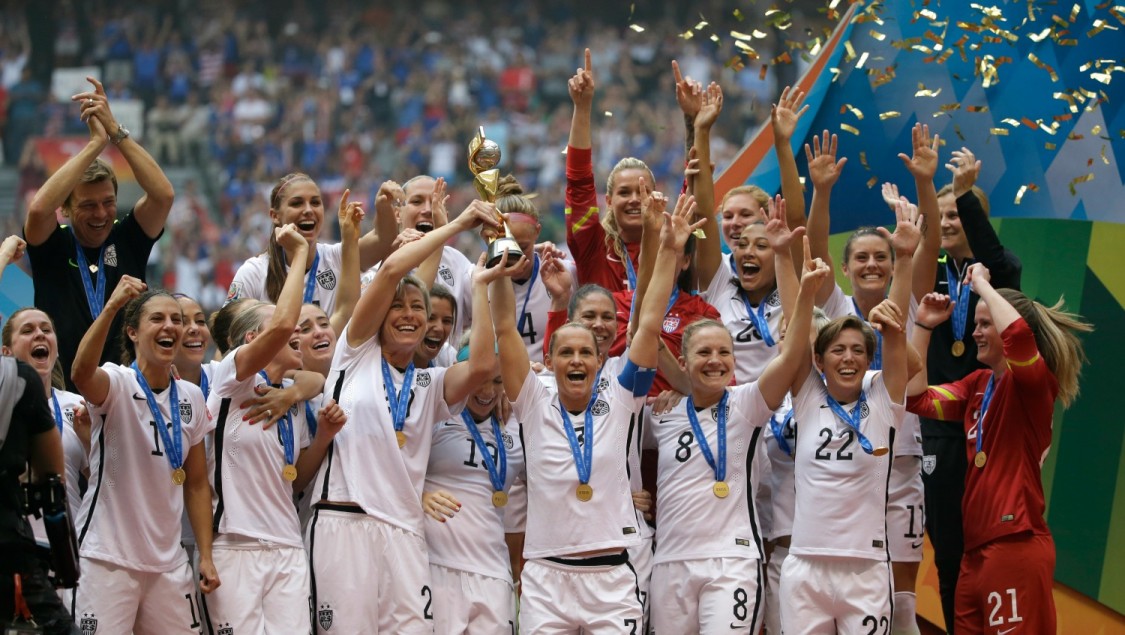USA just won the FIFA Women’s World Cup for the third time, defeating the defending champions Japan. It was an absolutely amazing end to a month long football festival that took place in Canada. The final game had everything a football fan could ask for. Early goals, a hat-trick, goals from set pieces, an amazing long distance goal, the other team not giving up till the end, proud coaches, loud supporters and even an own goal! And then came the trophy. Did you see it? Did you see how the trophy was comparatively smaller than the ones presented to the winners of the men’s world cup? Did you? I bet most of you didn’t.
I bet most of you didn’t even know that those brilliant football players played all of the matches on turf instead of natural grass. You might wonder what bad it would do to them, but let me enlighten you. Playing in turf is equivalent to rubber bullets flying after the players whenever they ran. The synthetic pitches bake in the sun. Clouds of rubber pebbles fly into players’ eyes, and the turf makes it difficult for them to gauge the way the ball will bounce. It’s not that the players did not protest over this topic. Earlier this year, 84 players representing 13 different countries dropped their lawsuit against FIFA. The players sued FIFA and the Canadian Soccer Association for gender discrimination because all six tournament venues were to feature artificial turf. In the months that followed, FIFA and CSA variously threatened protesting players with suspension, delayed a court decision despite the players’ need to know what surface the tournament would be held on so they could train accordingly, and suggested they would either defy an adverse legal ruling or cancel the tournament altogether. But as the tournament drew nearer, the players had to withdraw their lawsuit in order to allow the players and their coaches to focus exclusively on preparing for the unique conditions and challenges posed by artificial turf because what’s worse than competing for a World Cup title on artificial turf? Not competing at all! The World Cup is played once every four years and, for many of the players, it’s a once-in-a-lifetime opportunity, so they had to back down. But, had they been men, the law suit would have been a fixture of every international news cycle. Had been men, they would have gotten grass. Instead, the plaintiffs were women, and the dropped lawsuit received cursory news coverage before it evaporated altogether.
Well, not just the turf, even the pay gap is a real issue when it comes to FIFA. All the women’s teams competing in the world cup made only 2.6% of the money the men made. FIFA invested 576 million for the men in 2014 and only 15 million for the women this year. Even the 16 teams that did not make it out of the group stage in last year’s World Cup got paid four times more than the winning team. Why does this discrimination take place when it’s the same sport and the same tournament? Yes, the men’s World Cup brings in more money, but we also hear the hype about it for years before it actually starts. FIFA just doesn’t put as much into promoting the women’s teams and World Cup — only about 15% of what it spends on the men. Arguing that the women’s teams need to pull in the same viewing numbers to get paid more is not just nearly impossible, it’s absolutely unfair! Even then, the 2015 women’s World Cup final was the most-watched U.S. football game ever — including men’s. It’s clear that there’s not a lack of interest from viewers. The lack of interest comes from FIFA’s leadership.
One more thing that bothered me was the unfair draw conducted by FIFA this year. In every World Cup, seeded teams are dispersed among the groups in a random draw. But in this year’s Women’s World Cup , FIFA decided to assign the seeded teams to groups before the draw. That is, officials purposely chose where each team started the tournament and thus could pretty much predict that by placing top-ranked Germany in Group B and no. 3 France in Group F, those teams would likely meet in the quarterfinals. Now, they’d never be that dumb to do the same(make two titans play in quarterfinals) in case of the men’s World Cup, right? But FIFA had no problem doing it in the Women’s World Cup, where making sure the stadiums are filled takes precedence over ensuring any sort of compelling competition. Sure, these match-ups could have happened naturally, but the fact is that they didn’t. The path to the World Cup final was shaped by TV ratings and ticket sales. But, since FIFA promised to always use real grass in the future, hopefully they’ll also do a real draw next time.
The Women’s World Cup has far too much of a man-made element — an element that does not exist at the men’s World Cup. Women’s football teams have long fought for recognition and respect not just from the public, but also from the male organizers of the sport. Sweat-soaked, blood-stained, and turf-burned, the women of the 2015 World Cup redeemed the tournament and made it memorable for all the football fans around the world. They have inspired us in every possible way and have carved the path for young and aspiring footballers. Here’s to hoping that concrete steps will be taken to make things right with the World Cup players and that things will be better for women’s football in general.
Featured Image: AP

